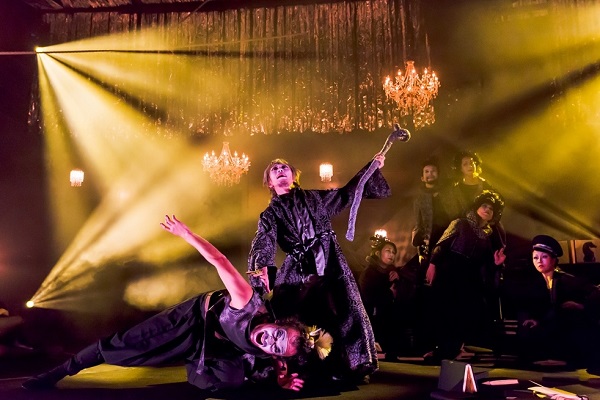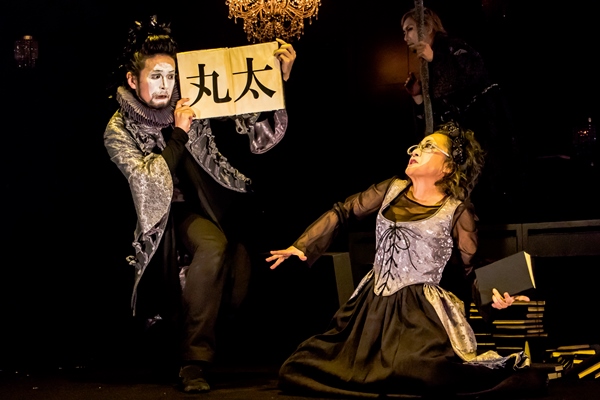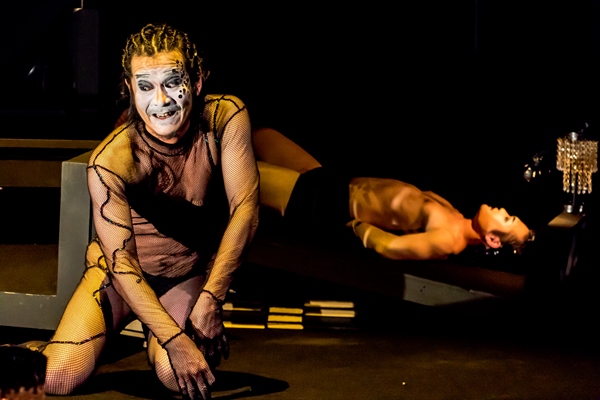ライブラリ
コラム
劇評/Performance Reviews
Repetitive Nightmare, Obsession of Written Language, or the Bermuda Triangle: Review of Yamanote-Jijosha’s The Tempest
Ted Motohashi (Tokyo University of Economics)

Prospero (Yoshiro Yamamoto) , Ariel (koki Ura) Photo:Toshiyuki Hiramatsu
In January 2015, Yamanote-Jijosha Theatre Company staged Shakespeare’s The Tempest, which according to its artistic director Masahiro Yasuda “is apparently an unexciting piece of work” that “seems to involve no significant events within it” (presented at Stage East, Ikebukuro Arts Theatre in Tokyo, From 14 to 18 January 2015. This reviewer attended the performance on the 15th). This short review is an attempt to analyze this presentation from the viewpoint of politico-historical context of colonialism symbolized by shipwreck and Atlantic slave-trade.
When we entered the theatre, we were embraced with serene baroque music and shower of blue light shining from the dark stage into the auditorium (set and lighting by Yuji Sekiguchi, music by Kohei Saimi). The light and music were somewhat too uncanny to be called beautiful, and created an eerie atmosphere of being left deep inside the sea: to be more precise, we felt as if we had been in Bermuda referred to in Shakespeare’s The Tempest, which had been the infamous place for shipwreck and pirates’ plundering in the Caribbean.
The performance started with a scene of tempest. This scene can be quite boring in staging this play. Whereas the original lines try to describe the devastating situation by saying “the storm” or “we split!”, it would be impossible for us to appreciate a spectacle, unless it is turned into a film. Yasuda’s direction solved this quandary with a touch of genius: as the opening classical music was replaced by mechanical noises suggesting self-destruction of modern scientific technology, a group of black-clothed men and women who could be interpreted as sailors represented the shipwreck scene in pantomimic gestures, into which fairies intervened by ripping apart the sailors’ black clothes. Throughout this performance, these ominous, ubiquitous, and sometimes violent fairies served as a kind of ‘silent chorus’, playing the part of characters in Prospero’s recollections, ironically commenting on his statements, or even “killing” him in the nightmare scene which I will later discuss.
This outstanding opening scene clearly indicated the fundamental thematic layer of this presentation: that is, modern, European, colonialist violence is the violence realized and executed through the power of representations. As Peter Greenaway’s magnificent film Prospero’s Books (1991) had illustrated, the theme of representing power had been revealed to be a significant undercurrent of Shakespeare’s The Tempest in both the manifestation and its self-annihilation of Prospero’s linguistic imperialism. Yasuda also underlined this theme by showing all the lines in this storm scene in the superscribed subtitles on the backstage screen. The cooperation between the discordant music, well-trained bodily movement of Yamanote-Jijosha’s actors, and superscribed signifiers contributed to creating the topos of violence of representations from the outset.
This topos was further highlighted by a plethora of “books”. Multiple volume of books were piled up on the stage, which were also used effectively as props: namely, sheets of cardboard that wrote Chinese characters such as “Sword” or “Log”, and pages of the books that were opened to show pictures representing “Sword” or “Log” occasionally served as those materials which possessed real power within the actions of play. The close relationship between “Books” and the violence of representations had been amply investigated in Greenaway’s film, although whereas his Prospero (played by the late John Gielgud) had been an omnipotent magus single-handedly controlling the power of representations, Yasuda’s Prospero (Yoshiro Yamamoto) here was unequivocally devoid of such power, whose desire for control miserably exceeded performance, with his connections with the “Books” and their might being pretty remote.
Let us linger for the moment upon the representation of “Log” in this play, where Prospero forced Ferdinand (Takeshi Kawamura) who had fallen love at an instant with Miranda (Junko Kurashina) to carry logs, in order to restrain his passion for her and to test the sincerity of his intention. Here in this case, a piece of log was either represented as Chinese characters “Log” written on an open page of a book, or as a picture of a “Log” sketched on a cardboard, either of which was carried very heavily and strenuously by Ferdinand, and lightly and effortlessly by Miranda. Needless to say, perhaps, measurement such as weight and values are only reflections of contingent historical power relationships that create representations. These logs carried by Ferdinand and Miranda, due to their very characteristics as representations through those “Signs”, became powerful metaphors which reminded us of the violence involved with sexual desire and slave labour. The poetic aesthetics manifested by Yamanote-Jijosha’s The Tempest was driven and underscored by the critical politics that examined, by revealing the arbitrariness within the system of signification,the deep-seated aspects of malaise and desire to colonially dominate other human beings.

Ferdinand (Takeshi Kawamura) , Miranda (Junko Kurashina) Photo:Toshiyuki Hiramatsu
In order to further excavate the pathology hidden within Self’s gaze toward Otherness, we have to analyze characterization of the three outstanding persona in this performance–Miranda, Caliban and Prospero. The key thematic notions behind their characters were, respectively, desire, memory, and nightmare, and their overarching psychological motif was repetition.
To our sheer consternation and embarrassment, Miranda in this version of The Tempest was persuasively characterized as a “middle-aged woman”, who seemed to be more fit for Prospero’s wife or whore than his daughter. It would be hard to imagine that Miranda had become middle-aged during the “12 years” while she had been surrounded only by Prospero and Caliban in this isolated and enclosed island: since it was impossible that Miranda who had been an infant when she and Prospero had been banished from Milan 12 years ago now became middle-aged, the “12 years” could be another term for “very long years” or “almost eternal”. In any case, this altogether unique Miranda was a ground-breaking representation of the woman who enjoyed freedom and ability to express her own desire, potently released from the stereo-typical image of innocent and chaste “maid”.
Turning our attention next to Caliban (Yoshinobu Iwabuchi), his characterization also shined through the director Yasuda’s astute observation of the mechanism of colonialism and its violent manipulation of human resources. Since his creation in 1611, Caliban had been one of the longest-standing and most representative icons of Western colonialist literature. On this stage, however, he was depicted, again in a remarkably revolutionary fashion, as a human being closely related to marine lives, rather than an inhabitant on an island. This did not mean, however, that he sojourned in the unrestricted geographical region of ocean; rather, he was bounded to a conscripted space within the hold of a ship that carried millions of African slaves in the Middle Passage across the Atlantic since the 16th century, the political space that symbolized bondage and suppression as well as resistance and resilience. To suggest this historically multi-layered presence within Caliban, Yasuda, with a sleight of hand, presented two more “Calibans”, or his shadowy figures, which in effect “tripled” him on the stage. One was the half-naked man tortured almost throughout the performance on a bed in a ship’s deep-hold, crying in pain. Whenever he cried, the ship also creaked as if in pain, and the gorgeous chandelier in Prospero’s courtly room flickered. Colonialism’s violence upon the slave’s body was amplified by the flickering light shining in the magical chamber and by the creaking bed that indicated implosion of Western individualism. This second “Caliban” was referred to by the first “real” Caliban, who exclaimed: “he is I; that man was my true self”. This figure represented Caliban’s past memory as a slave, as well as his present recognition of his own status. Then the third “Caliban” appeared for a brief moment during Prospero’s “nightmare” scene (discussed below): without any utterance, he violently banged a black piece of metal on an anvil in an act totally irrelevant to that of slave labour, which raised an ambivalent image of uncanny resistance by a slave on one hand and oppressive regime administered by a slave-driver on the other. The banging noise, which echoed at the same time a blacksmith’s toil and a prisoner’s escape from the jail, rekindled a signal fire for revolt by the colonized. It was also an alarm bell toward dissecting the universal pathology of colonialism that strengthened the Manichean dualism between domination and subjugation, while repeating the colonialist violence of representations through mimesis and consent. The reason why this uncanny sound promoted by the “Third-term Caliban” was so disturbing that, unlike the sound effects frequently employed on this stage to suggest the violence of representations, this had a real potential to transgress boundaries between slaves and slave-owners, as it was produced from the deepest lacuna of the actor’s body. These “Calibans”, being an integration of the tripartite structure made of a “monster”, a “slave” and a “revolutionary”, who observed and witnessed the slave and the slave-driver as his own self, transcended these three figures by reversely radiating the obedient and revolting image of proletariat that lay at the foundation of modern colonialist capitalism. Incidentally, in this presentation, Caliban’s image as a “creator of alternative history” as well as one of the “first proletarian poets”, which had been so powerfully evoked in Shakespeare’s original was not focused in this performance, precisely because there was no room for Caliban’s “real dream” on this island where Prospero’s “illusionary nightmare” was exhibited, to which we now turn.

Caliban (Yoshinobu Iwabuchi) Photo:Toshiyuki Hiramatsu
It has been a norm of postcolonial presentation of The Tempest that indicates Prospero’s limits and contradictions. Yasuda’s direction quite radically exceeded those postcolonial interpretations by almost grotesquely focusing on Prospero’s inability and feebleness both as wizard and colonizer, and this was not more eloquently illustrated anywhere else than by the “masque” which was supposed to celebrate the engagement between Miranda and Ferdinand, as Prospero took this opportunity to boast his magical might to satisfy his “vanity”. Again this scene could tire the contemporary audience as the spectacle involves goddesses and farmers that are hardly of interest to modern spectators. However, this scene is important within Shakespeare’s overall scheme as it represents a pathology of colonialism as well as a process of its own demise. Here again Yasuda’s excellence was obvious as he presented this scene as Prospero’s recurrent nightmarish vision. As the serene and beautiful lighting and music became muddled and disturbed, the masque that could have been a showcase of magical wonder was instantaneously descended into a nightmare revealing the colonizer’s suppressed fear and anxieties. Within that vision, Prospero was murdered by Ariel (Koki Ura) and thrown into a coffin. Furthermore, Yasuda remarkably let murdered Prospero recite lines reminiscent of Hamlet’s famous soliloquy: “To die, to sleep. To sleep eternally, and perhaps to dream again.” The reason why any nightmare is hideous and attractive at the same time and people will never awake from it is because nightmare is not ontological but epistemological. In this sense, nightmare is quite akin to the “Ghost” of Hamlet. We fear ghost and nightmare not because we see them but because we think we see them: in Hamlet’s words, they are “not seems” but “that within”. Prospero’s nightmare in Yasuda’s version of The Tempest repetitiously revealed the colonialist pathology in that the colonizer represented his own death as an omen of demise for the desire to control others.
In this play, everything–from motifs, themes, images to actions, sentiments, even lives and deaths–repeated themselves, as if the colonizer had been unable to live without his native customs brought with him. Prospero, the linguistic imperialist obsessed with the power of representations would never be able to be awaken from his nightmarish visions. The three obsessions involved with desire, memory and nightmare were nothing but the pathological signs of sentiments, aspirations and fears that had been at the basis of Western modernity. Colonialism with its epistemological disease is always already supported and threatened by the presence of slave and shipwreck. The bed on which “Caliban” cried in pain was a negative of the coffin in which the able slave-owner Prospero dreamed of his own impotence. What Prospero exhibited in his nightmare was that his island that could have been a utopia for the colonizer was revealed to be a distopia for all the human beings.
Finally let us refer to the “triangular relationship” on this island floating in the Bermuda sea. In this presentation of The Tempest, the relationship between the characters were always represented on the stage in a triangular fashion: Prospero/Miranda/Caliban, Prospero/Miranda/Ferdinand, Caliban/ Trinculo (Michiko Okubo)/Stephano (Yosuke Tani), Jovanna Queen of Naples (Emi Yamaguchi)/Sebastian her brother (Takuyuki Sato)/Antonio (Kazuhiro Saiki)…. This version went as far as to maintain this tripartite structure by cutting Milanese courtier Gonzalo and giving some of his lines to Antonio. “Three” not only meant transcending dualism but also “indefinitely many”: this also showed Yasuda’s keen observation towards colonialism that was a complex reaction of amplified hunger and sickness rather than a simple Manichean opposition between the colonizing and the colonized, as this stage presented a chain of representative violence in the triangle and amplified it through the multiplied presence of the fairies. The powerful bondage of written language would never release the colonizer’s selfhood in the domino effect of nightmare that eternally caught those who believed that they controlled the power of representations.
However, there was a single character who was not trapped in this triangular relationship–Ariel. On this island and in the surrounding oceanic region, only Ariel appeared to maintain his individual freedom. With the fairy’s ability to freely change shapes, and ventriloquism mimicking Prospero’s voice from the auditorium, Ariel was the sole master in the Bermuda Triangle, the infamous spot of shipwreck and the home of pirates, where from the ancient period a number of colonialists had perished. Unlike Prospero and Caliban, Ariel would never dream a dream; he was alien to both past illusions and present pain; he was not concerned with any ideology or religion, and therefore could be the genuine executor of violence. Probably because Ariel was not a possessor of the power of representations, but the representation itself, he was naturally one with the various representations on this stage–beautiful shapes such as bubbles,watery showers, maelstrom of light, sound of folkloric music, human breathing under the water, as well as ugly phenomenon such as vomiting, drunkenness, ruined beds, stains of paint. Not being bounded by, nor appropriating the power of written language, Ariel felt no need either to execute or resist colonialism: his theatrical presence may have been a trace of hope for the eternally deferred future, future that would ascertain equality and justice, having survived the epistemological malaise of colonialist representations.
In the Bermuda Triangle with the three pinnacles of colonialism, slave-trade and wrecked ship, what we had been left with us, finally, was an unfinished documentary directed by Ariel about a lost colonizer. Yamanote-Jijosha’s The Tempest was at once a past nightmare of the colonizer Prospero and a present reality of the slave Caliban, as well as an eternally postponed future of the postcolonial anti-labourer Ariel. Was the triangle bondage dissolved by Ariel’s flight and Prospero’s departure? Would the epistemological disease be healed by the sheer presence of bodily existence? Answers could reside with the sojourning audience who had been traveling through The Tempest and invited to an eternal seafaring with the unnamed characters on the stage.